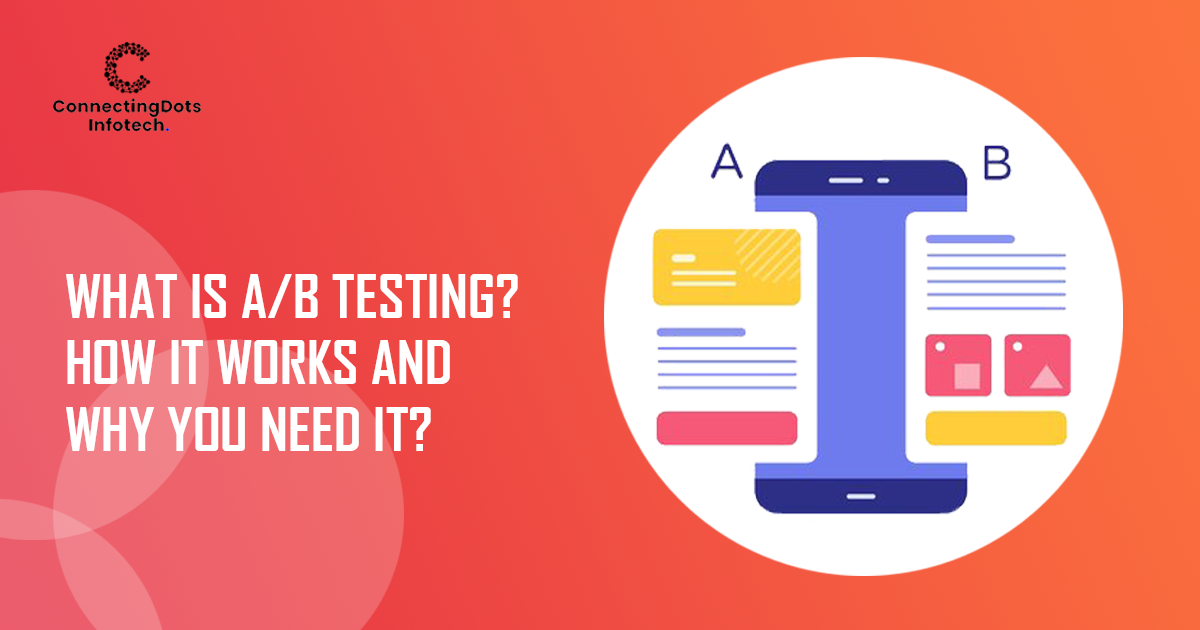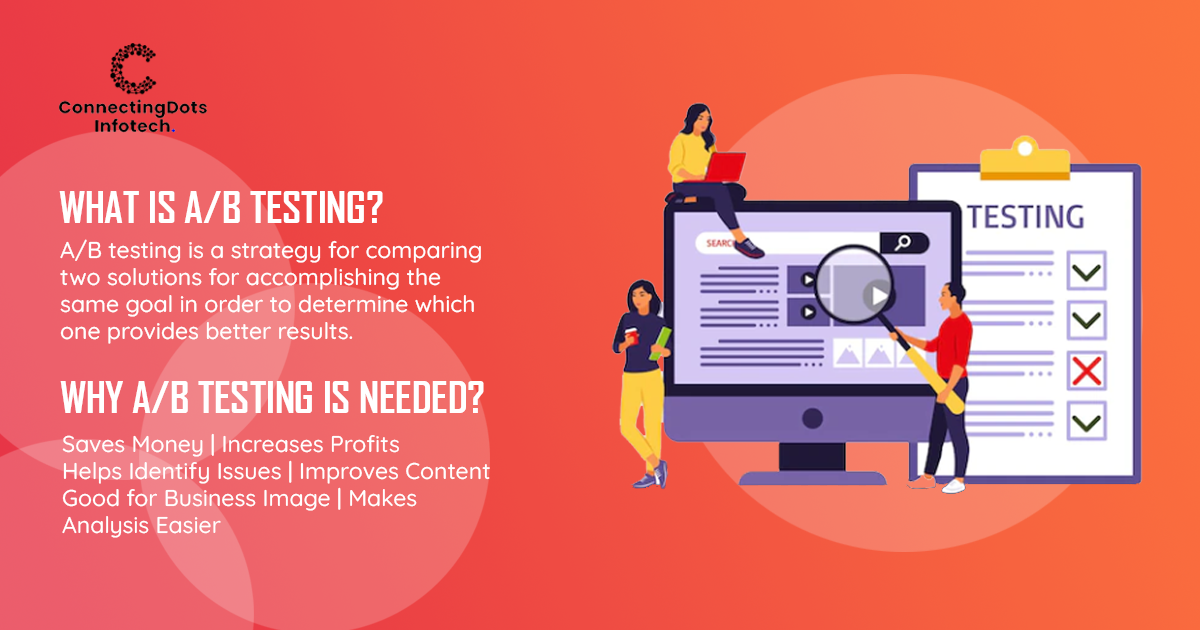What Is A/B Testing? How It Works And Why You Need It?

Data is all around us. Whether you're a single person, a small business, or a global corporation, you must deal with a lot of data, especially customer data, in order to serve customers and enhance your bottom line.
Marketers employ a range of strategies to boost earnings. Understandably, not all approaches will work or be equally beneficial in every situation.
You can't run a campaign based on a gut feeling or a hunch. You'll need figures, but they won't always be obvious. This is why companies require A/B testing, a one-of-a-kind tool for determining the best course of action.
What is A/B Testing?
A/B testing is a strategy for comparing two solutions for accomplishing the same goal in order to determine which one provides better results.
We utilize A/B testing on a daily basis, and the method is supposed to be over a century old. However, because of the emergence of online marketing, it is currently becoming more popular. A/B tests are used by marketers to evaluate two marketing approaches in order to determine which one provides the highest return on investment; however, this isn't the only application of A/B testing.
In the 1920s, biologist and mathematician Ronald Fisher devised randomized controlled trials. He figured out the fundamental math and laws, and this notion became a science. Fisher conducted a series of agricultural experiments to answer basic concerns such as what happens if I use different fertilizers or apply additional fertilizer.
The concepts he proposed proved to be correct, and in the early 1950s, scientists began conducting clinical trials in the area of medicine. In the late 1960s, marketers modified the strategy. They want to see if direct marketing tactics, such as personalized letters or postcards, increase sales.
A/B testing, on the other hand, was not the same back then. It was in the mid-1990s that it took on its current form. It employs the same ideas, but in a virtual and real-time context.
How Does A/B Testing Work?
A/B testing may appear to be a complicated concept, but it is actually rather easy. The first step is to determine what you want to test and why you want to test it.
Let's assume you want to check how many people 'purchase' if you modify the size of the 'Buy Now' button on your website, i.e. make it larger or smaller. Once you've decided what you want to test, you'll need to figure out how you'll analyze the results.
The number of individuals that click on the button, for example, can give you a fair idea of how the button's size affects perception.
You may also make a judgment based on the number of final customers, although this may not be a fair alternative because visitors may abort a purchase for a variety of reasons. You'll need to separate users into two groups in the following stage. Unless you're seeking to see how users from a certain demographic respond to a change, the collection must be random.
Create two pages that are identical but have different button sizes. Examine the stats to determine which page receives the most clicks. The placement of the button, the color of the font, and the device being used all influence the decision to click. You may categorize your users into two groups: mobile users and desktop users, for example.
This is due to the fact that the same button may show differently to mobile and desktop users. You'll be able to choose which button to serve to certain users this way.
Make sure you calculate the size of your sample accurately to ensure that the outcome is accurate and not tainted by background noise.
For example, mobile visitors may detest pressing buttons, or the button on the desktop form of your website may not be placed appropriately. Because of the randomization, one group may have more mobile phone users than the other, resulting in one set having a lower or higher rate, independent of the button size.
The ideal method to eliminate such biases is to separate visitors into desktop and mobile users, then assign them to different groups at random. Blocking is the term for this technique.
Why A/B Testing is Needed?
Let’s learn why A/B testing is needed:
Saves Money
Businesses may save money by using A/B testing to uncover methods that provide better results. No two marketing initiatives will yield the same results; one will always outperform the other.
Businesses may use A/B testing data science to determine the alternative that provides greater returns and eliminate the procedure that provides lower returns, allowing them to spend their money where it pays the most.
Increases Profits
As stated in the AB testing definition, it aids in the rise of earnings by increasing conversions and allowing the company to reach a larger audience. Approximately 60% of organizations feel it improves conversion.
Furthermore, the outcomes of A/B tests might reduce bounce rates and enhance engagement. These elements are critical for a company's growth. At the end of the day, the firm starts to make more money as a result of lower expenses and more sales.
Helps Identify Issues
Many marketing strategies fail as a result of little mistakes. These problems may be detected using the best AB testing tools, allowing a firm to function smoothly.
It can aid in the detection of a variety of issues, including bad UX design. This is significant since a better design may boost conversion by up to 400%.
Improves Content
Regardless of what anyone says, content still reigns supreme. The difficulty is that there are so many possibilities to pick from, such as written material, graphic content, and so on.
Unless you have a solid A/B testing analysis of data, you can't just be sure what will work and what won't.
Good for Business Image
A/B testing has grown extremely common, with over 70% of businesses conducting at least 2 tests per month. A/B testing for websites enables companies to eliminate processes or stages that create a negative impression on customers.
As a result, the company's reputation improves and goodwill grows.
Makes Analysis Easier
A/B testing is used by about 77% of firms to detect design, typography, and other problems on their websites (especially landing pages).
This helps to prevent cart abandonment by emphasizing the factors that lead to cart abandonment. There are a lot of causes for this, including bad layout, hidden fees, and so on. Businesses may utilize A/B testing to identify the root reason and address it.
More Engagement
Companies want engaged followers and consumers, therefore it's no surprise that 59% of companies do A/B testing on email. It may assist organizations in determining which kind of content is most effective, allowing them to focus more on those types of content.

Conclusion
Some of the world's largest firms employ historical, demographical, and behavioral data in vast A/B testing. A/B testing is used by Amazon to assess the performance of their sophisticated recommendation engine. A/B testing was used by Netflix to support the production of its Top 10 lists. Given Amazon's and Netflix's distinct industry achievements, A/B testing is an important tool to have in your product management toolkit.
